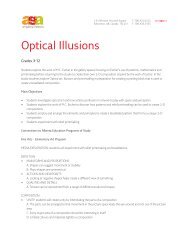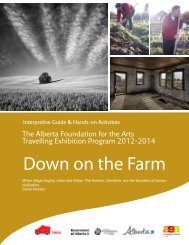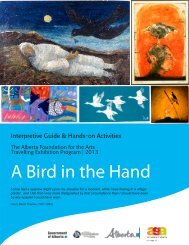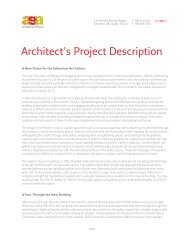Urban Animals - Art Gallery of Alberta
Urban Animals - Art Gallery of Alberta
Urban Animals - Art Gallery of Alberta
Create successful ePaper yourself
Turn your PDF publications into a flip-book with our unique Google optimized e-Paper software.
The <strong>Alberta</strong> Foundation for the <strong>Art</strong>s Travelling Exhibition Program<br />
Elements and Principles <strong>of</strong> Design Tour<br />
LINE: An element <strong>of</strong> art that is used to define shape, contours and outlines. It is also<br />
used to suggest mass and volume.<br />
See: Mother Bear and her cub in the back alleys <strong>of</strong> <strong>Alberta</strong>, 2012 by Jason Carter<br />
What types <strong>of</strong> lines are there? How can you describe a line? What are some <strong>of</strong> the<br />
characteristics <strong>of</strong> a line?<br />
Width: thick, thin, tapering, uneven Length: long, short, continuous, broken<br />
Feeling: sharp, jagged, graceful, smooth Focus: sharp, blurry, fuzzy, choppy<br />
Direction: horizontal, vertical, diagonal, curving, perpendicular, oblique, parallel, radial, zigzag<br />
Now, descibe the lines you see in this image. Follow the lines in the air with your finger.<br />
What quality do the lines have? How do the lines operate in the image?<br />
Most <strong>of</strong> the lines in this image are diagonal, horizontal, or vertical in nature. Diagonal lines are<br />
seen on the roadway and on the bear cub. The diagonal lines <strong>of</strong> the road lead the viewer’s eye<br />
back to the house at the ‘top’ <strong>of</strong> the picture. The diagonal lines <strong>of</strong> the bear cub create a sense <strong>of</strong><br />
movement and give the appearance that the cub is walking. The vertical lines <strong>of</strong> the tree trunks<br />
and the brown buildings on the right <strong>of</strong> the picture lead the eye from the bottom <strong>of</strong> the picture<br />
plane to the top and, as the trees receed in the distance these lines move closer together,<br />
adding to the idea <strong>of</strong> distance in the work. The horizontal lines (Mother bear’s body; roadway;<br />
ro<strong>of</strong> tops) lead the eye across the image and help tie one part <strong>of</strong> the painting to the other.<br />
Line can also be a word used in the composition meaning the direction the viewer’s eye<br />
travels when looking at a picture. How does line in this image help your eye travel within<br />
the composition?<br />
The lines created in the composition allow our eyes to travel around the work in a very dynamic<br />
way. The number <strong>of</strong> lines and variety <strong>of</strong> lines create a sense <strong>of</strong> energy in the work which may<br />
reflect the actual movement <strong>of</strong> the bears through this urban space.<br />
AFA Travelling Exhibition Program, Edmonton, AB Ph: 780.428.3830 Fax: 780.421.0479<br />
youraga.ca

















